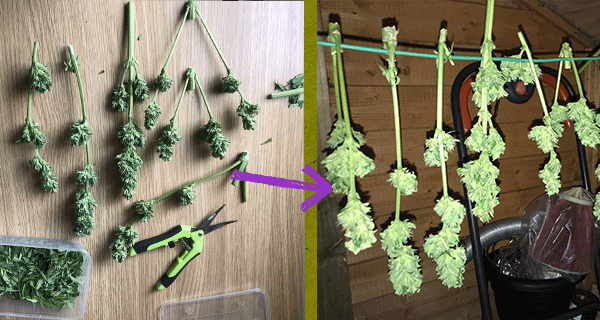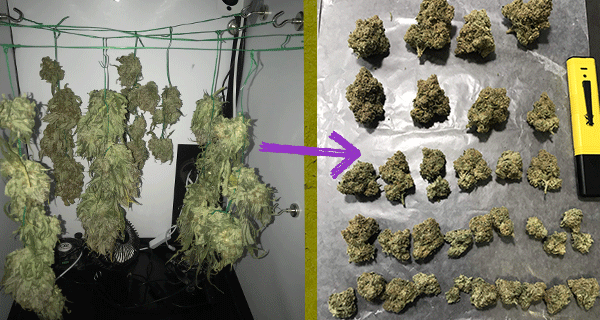Wet vs Dry Trimming Cannabis: Which Should You Choose?
Published : Aug 25, 2020

Are your cannabis flowers looking ripe and ready? You're one step closer to tasting the fruits of your labour. But first, you need to process your flowers. One step of this process is trimming—removing sugar leaves to enhance the flavour and overall smoking experience. Discover the pros and cons of the wet and dry trimming methods.
Growing cannabis involves seeing your plants through several stages of growth. While all of them are important to securing good yields, the late flowering stage and harvest period are by far the most exciting. In the middle of the hustle and bustle of preparing to harvest the impending botanical bounty, growers can often forget that more work needs to be done.
Before kicking your feet up with a well-deserved joint between your thumb and forefinger, you’ll need to process your flowers in the right way.
Cannabis Cultivation Doesn’t End After Harvest
The first job on the list? Trimming. This seemingly menial task might appear like it requires no thought at all—quite the opposite. Done right, trimming will elevate your hard-earned flowers to the next level of quality. They’ll look great, taste great, and create buttery smooth smoke with each toke.
When it comes to trimming buds, growers have two options: wet trimming and dry trimming. Each of these methods offers its own advantages, depending on the amount of flower and the grower’s own preferences.
Discover the pros and cons of each processing technique below to see which one will work best for your situation. Before we jump into the nitty-gritty of cannabis trimming, let’s go over why you should trim in the first place.
What Is Trimming, Exactly?
Trimming cannabis flowers involves cutting away sugar leaves, branches, and stems. Removing this material from the cannabis cola creates manicured, nugget-shaped flowers that look and taste awesome.
Growers perform this all-important task at some point after harvesting and before curing. But why do so at all? Wouldn’t it just be easier to skip all the hassle and smoke more rugged buds? Don’t the sugar leaves also contain cannabinoids? Keep reading to find out why you should trim every time you harvest.
Why Should You Trim Your Buds?
Tidying up your cannabis flowers offers a wide range of benefits. The trade-off between performing this simple act and receiving an enhanced smoking experience really is a no-brainer. These are the top reasons you should trim your cannabis flowers.
Higher THC Concentration
Trimming your buds will remove most of the sugar leaves—small structures found on cannabis colas. Although these smaller leaves are an essential aspect of flower formation, they reduce the THC concentration of each bud. Sugar leaves contain less THC than flower tissue, so processing and smoking them alongside your flowers means less THC with each hit.
Reduce Instances of Mould
Fungal pathogens can strike at any time between the flowering stage and the end of curing. If left unchecked, these hungry microbes can ruin an entire harvest. They thrive in a moist environment with stagnant airflow and slowly spread across the surface of cannabis flowers. Leaves can provide pockets of trapped air and moisture—the ideal conditions for mould to gain a foothold.
They Look Better
Have you ever bought buds from a reputable dispensary or coffeeshop? You probably stopped to appreciate how good they looked. Properly manicured flowers boast a compact, jewel-like appearance that looks almost good enough to eat! But don’t do that; just impress your smoking buddies with buds that look top-shelf.
Taste, Aroma, and Smoking Experience
Removing all of those sugar leaves ditches a bunch of chlorophyll that feels harsh when inhaled. After snipping them away, the delicious terpene profile of your flowers will become more pronounced, and the smoke much more smooth.
Now that you know the impressive benefits of trimming, you’re almost ready to select your preferred technique. Before we jump into it, we’ll show you what tools you’ll need to get the job done.

Tools for Trimming
In truth, you don’t need many tools. After all, trimming only consists of snipping away excess foliage. However, there are a few specific bits of gear that make the job much easier.
• Trimming scissors
Your trusty weapon of choice. These small but effective tools feature sharp blades that make easy work of sugar leaves, branches, and stems. The narrow, pointed tips enable growers to hone in and remove leaves without damaging flowers. Curved trimming scissors make the job even easier and allow you to work around the natural shape of the buds.
• Collection tray
Trim your flowers over a collection tray. You can use products specifically designed for the job, or simply grab a bowl or dinner plate. Although sugar leaves aren’t as desired as the flower itself, they still contain enough cannabinoids and terpenes to craft some nice hash or concentrates.
• Gloves
Although not essential, gloves make trimming a whole lot easier. Ripe cannabis flowers are fountains of resin. Handling them with bare hands means this viscous substance will soon build up on your palms and fingertips. Use tight-fitting gloves to maintain your dexterity.

All About Wet Trimming
As the name suggests, wet trimming involves manicuring buds fresh off the plant. During this time, the moisture content in the flowers remains high. Trimming immediately after harvest makes logical and linear sense, but some growers choose the other method. Check out the advantages and disadvantages of wet trimming below.
Pros of Wet Trimming
• Banishes moisture
Sugar leaves create pockets of humidity against the surface of the flower. Removing them will eliminate potential hotspots for mould. Considering such fungi can compromise your entire crop, trimming the leaves before drying is extremely appealing to many growers, especially those in humid climates.
• Preserves the good stuff
You’ve probably noticed those shiny, crystal-like dots on your cannabis flowers. As it happens, a greater number of these sparkly substances, known as trichomes, means a higher volume of cannabinoids and terpenes.
When wet trimming, the trichomes remain firmly intact and locked in place, removing the risk of dislodging these important structures while cleaning up your flowers. Enjoy the full genetic expression of your buds!
• Keeps things easy
Wet trimming saves a lot of fiddling. Both beginners and more advanced growers will find it much easier to remove the leaves while they are wet and still structurally sound. When leaves dry up, they curl and lay against the flowers. Removing them before this happens saves a considerable amount of time and effort.
• Maximises drying space
You’ll find you can fit a lot of flowers on your drying rack by wet trimming first. After removing sugar leaves, branches, and stems, you’ll recover the horizontal surface area on your drying rack. Subsequently, you’ll be able to dry more flowers at one time and ramp up processing efficiency.
• Linear and logical
Wet trimming maintains an easier and more simplistic workflow. Growers harvest their flowers, trim them, dry them, and then cure them in an efficient pattern. Going from point A to B helps cultivators simplify the process and keep things moving.
Cons of Wet Trimming
• Sticky, sticky work
The high water content of wet buds makes their psychoactive resin all the more sticky. Although you should celebrate sticky buds, they swiftly become a pain when trying to remove intricate sugar leaves. Wet trimming will leave your hands and trimmers coated in resin—awesome for hash, but a pain in the ass.
• Drying rate
Removing sugar leaves minimises mould by getting rid of moisture pockets, but this is a double-edged sword. The lack of moisture also leads to flowers drying out faster. This saves time in the long-run, but you need to be careful that your buds don’t become too dry and lose their flavour.

All About Dry Trimming
Dry trimming involves—you guessed it—removing a large amount of moisture from your buds before snipping away at them. Growers typically cut their mature plants at the base and hang them in a drying room. Removing individual branches from larger plants makes them easier to manage.
After around ten days of drying the plants at a low temperature, they’ll be ready for a trim. At this point, the sugar leaves become shrivelled and slightly discoloured. They are much less sticky, but also take more dexterity and precision to remove. Find out if dry trimming will help you optimise your growing operation.
Pros of Dry Trimming
• Slower drying
Waiting ten days for your buds to dry might seem excessive, but the reward outweighs the wait. The presence of sugar leaves and the resulting trapped moisture means your buds will take longer to lose their water content. However, this longer drying period helps to maintain the terpene profile. You won’t lose any of the unique taste or aroma of your favourite strain.
A longer drying period becomes particularly useful in climates with low humidity, preventing buds from drying too fast and becoming harsh.
• Less sticky
Cannabis flowers lose a large portion of their water content during drying. The viscous resin and sticky trichomes harden off and become a lot less sticky, making flowers far easier to trim. The ability to handle flowers without them sticking to every fingertip enables experienced growers to trim a lot faster.
Cons of Dry Trimming
• Trichome loss
Hard trichomes are susceptible to becoming dislodged during trimming. They make the process less sticky, but you’ll likely lose a few in the process. But look on the bright side—you can make some killer hash out of anything that falls into your collection tray.
• You’ll need more space
Hanging up entire plants or large branches requires more space than a drying rack, especially if you’re processing a lot of plant material. Most growers elect to hang their branches from wire or string. Ideally, you’ll need to set up a spare room or large closet to get the job done.
• Discolouration
Dry-trimmed buds tend to lose their luscious green colour and develop more of a brown-yellow appearance. Although they still taste great, the loss of aesthetics reduces the immediate visual appeal of your flowers.

Dry vs Wet Trimming: Which Way Should You Go?
Both dry and wet trimming reach the same end goal. They remove excess plant material from cannabis flowers and prepare them for the curing process. Overall, wet trimming serves as an efficient and easy way to process smaller homegrown batches and keep things flowing.
In contrast, dry trimming comes to the fore when dealing with a large number of plants. Plus, the longer drying time really helps lock in those unique flavours.
Which one should you choose? It’s entirely up to you! Weigh up the pros and cons of each method to decide how you want to process your plants.






































